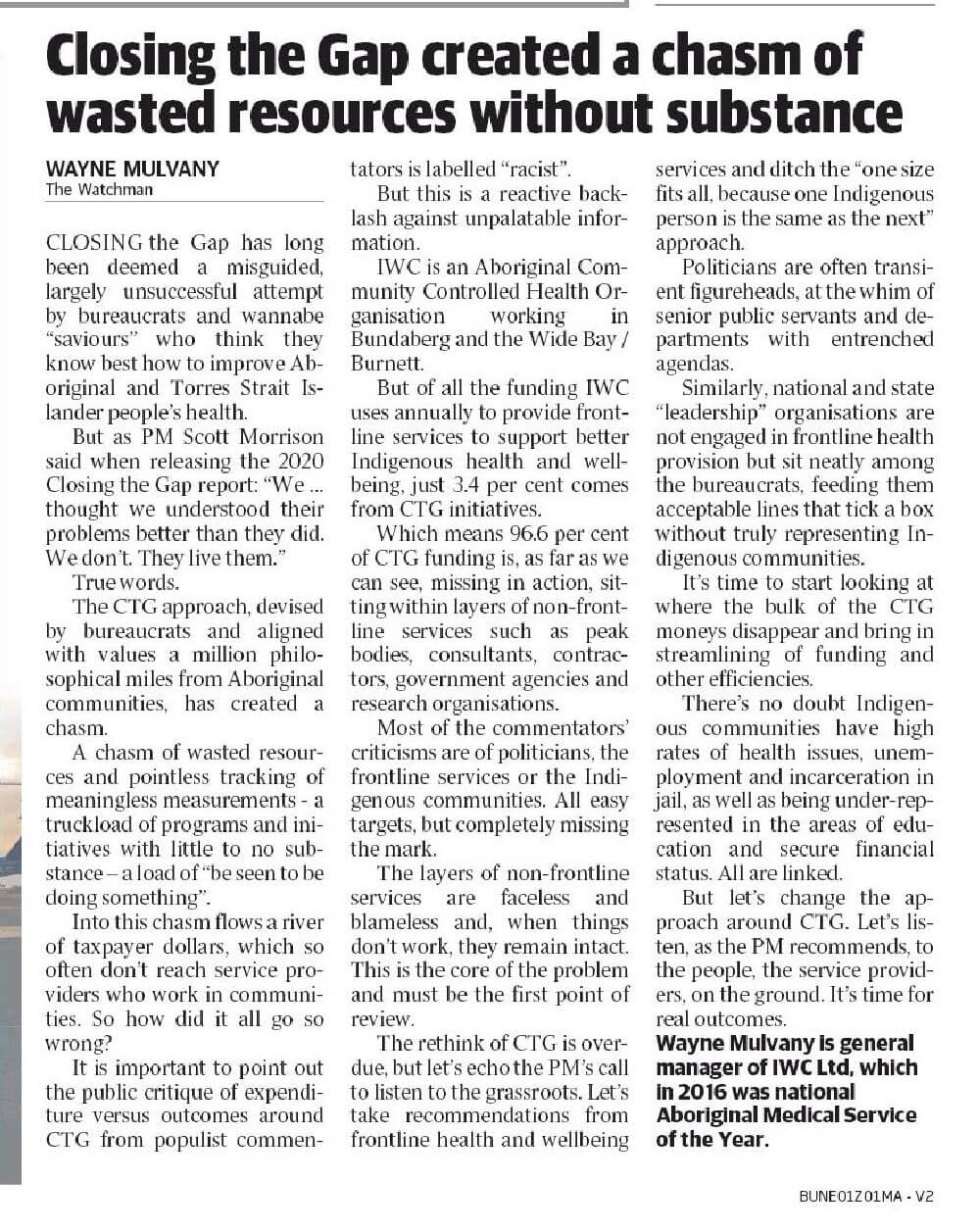Closing the Gap has created a chasm, filled with freeloaders
CLOSING the Gap has long been deemed a misguided, and largely unsuccessful, attempt by bureaucrats and wannabe “saviours” who think they know best how to bring about improvements in health for Aboriginal and Torres Strait Islander peoples.
But as PM Scott Morrison said on February 12, when releasing the 2020 Closing the Gap report: “We … thought we understood their problems better than they did. We don’t. They live them.”

True words. Refreshingly so.
It is a fact that the Closing the Gap approach, devised by bureaucrats and aligned with values that are a million philosophical miles from our Aboriginal communities, has created a chasm.
A chasm of wasted resources and pointless tracking of meaningless measurements spanning 12 long years. A truckload of programs and initiatives with little to no substance – just another load of “be seen to be doing something”.
Into this chasm flows a river of taxpayer dollars which, more often than not, are just not hitting the coalface service providers who live and work in our communities.
So how did it all go so wrong?
It is important to point out that the ongoing public critique of expenditure versus outcomes around Closing the Gap from many populist commentators often is labelled “racist”. But I would say this is a reactive backlash against unpalatable information, and that those commentators’ assessments do have context and justification.
IWC – Indigenous Wellbeing Centre Ltd – is an Aboriginal Community Controlled Health Organisation (ACCHO). We work hard to deliver culturally responsive initiatives on the ground here in Bundaberg and the Wide Bay / Burnett, regions of high disadvantage. But of all the funding IWC uses annually to provide frontline services to support Aboriginal and Torres Strait Islander people to achieve better health and wellbeing, just 3.4% comes from Closing the Gap initiatives.
Which means 96% of Closing the Gap funding is, as far as we can see, missing in action. We suspect it is sitting within the layers of non-frontline services such as peak bodies, consultants, contractors, government agencies and research organisations, among others.
In relation to the populist commentators, the majority of their criticism is focused on either the government of the day (politicians), the frontline services and / or the actual Indigenous communities, which are easy targets. But this is completely missing the mark.
The layers of non-frontline services referred to above are faceless and blameless and, when things are not working, they remain intact – and this is the core of the problem. This must be the first point of review.
The rethink of CTG is long overdue, but while we’re about it let’s echo the PM’s call to LISTEN. But let’s listen to the grassroots communities, not the faceless layers taking big pay checks and the cream of funds from the CTG initiative.
Let’s take on board the recommendations of the frontline health and wellbeing service providers who know what their communities need, because they live and work with them. And let’s ditch the “one size fits all because one Indigenous person is the same as the next” approach and take a more considered, tailored method.
Most importantly, politicians are often transient figureheads, at the whim of powerful and long-term senior public servants and departments with entrenched opinions and agendas.
Similarly, national and state “leadership” organisations are not engaged in frontline health provision but sit neatly among the bureaucrats, feeding them acceptable lines that tick a box without truly representing our Indigenous communities.
The issues around CTG sit within the unnecessary layers which soak up funding, the need for which is extremely questionable. If CTG is to make a difference, it’s time to start looking at where the bulk of the monies disappear and bring in streamlining of funding and other efficiencies. Then we will see true outcomes start to flow.
There is no doubt that Australia’s Indigenous communities continue to have high rates of health issues and diseases, unemployment and incarceration in jail compared to the mainstream population, as well as being under-represented in the areas of education levels, home ownership and general attainment of secure financial status. In many ways, all of these are linked and do not stand in isolation.
But there is an old saying that people “need a hand up, not a handout”. Let’s change the approach around CTG. Let’s listen, as the Prime Minister recommends, to the people, the service providers, on the ground. It’s time to deliver real outcomes.
Wayne Mulvany is General Manager of Indigenous Wellbeing Centre Ltd
IWC is an Aboriginal Community-Controlled Health Organisation (ACCHO) and Registered Charity that provides services to all people, Indigenous and non-Indigenous, as it works to deliver Reconciliation in Action. In 2016, IWC was named AGPAL (Australian General Practice Accreditation Limited) national Aboriginal Medical Service of the Year.